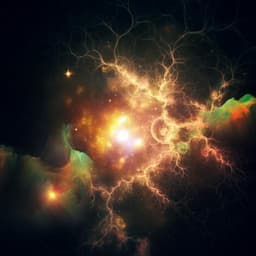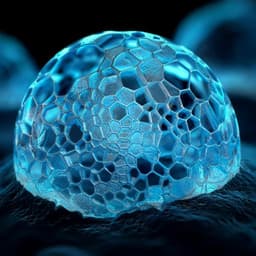
Physics
Ubiquitous spin freezing in the superconducting state of UTe₂
S. Sundar, N. Azari, et al.
This study conducted by Shyam Sundar and colleagues unveils intriguing magnetic clusters within UTe₂ single crystals. Observing a freezing phenomenon at low temperatures, the researchers highlight how this magnetic inhomogeneity may alter our understanding of the material's intrinsic characteristics.
~3 min • Beginner • English
Introduction
The study addresses whether the unconventional superconductor UTe₂ hosts spin-triplet pairing and what magnetic fluctuations underlie its superconductivity. Spin-triplet superconductors are of interest for spintronics and topological quantum computation. UTe₂ exhibits several hallmarks of spin-triplet pairing (weak Knight-shift change across Tc, very large and anisotropic Hc2 exceeding Pauli limit, field-reentrant superconductivity). However, the nature of its magnetic fluctuations (ferromagnetic versus antiferromagnetic), their spatial homogeneity, and their role in superconductivity remain debated. Additional unresolved issues include a residual T-linear term in specific heat below Tc and a ubiquitous low-T upturn in C/T, both sample dependent. This work uses muon spin rotation/relaxation (µSR) on independently grown single crystals to probe internal magnetic fields and dynamics over a broad temperature range, aiming to reveal whether magnetic inhomogeneity and spin freezing occur and how they relate to the thermodynamic anomalies.
Literature Review
Prior experiments suggest spin-triplet superconductivity in UTe₂: small Knight-shift change across Tc depending on field direction; very large, highly anisotropic Hc2 well above Pauli limit; and re-entrant superconductivity in very high fields. Chiral in-gap surface states and polar Kerr effect imply time-reversal-symmetry breaking and a possible two-component order parameter with topological character. Magnetically, magnetization scaling and µSR suggested proximity to a ferromagnetic (FM) instability, while early inelastic neutron scattering (INS) emphasized low-dimensional antiferromagnetic (AFM)-like fluctuations; later work tied these excitations to heavy-band structure, leaving FM vs AFM unresolved. Theoretically, itinerant f-electron models predict FM fluctuations along the a-axis at ambient pressure; localized f-electron and ladder geometry can yield frustration and coexisting FM/AFM fluctuations. Thermodynamically, some samples show a double specific-heat transition at ambient pressure (others single), with pressure inducing two transitions. A ubiquitous residual T-linear specific heat term γ* and a low-T upturn in C/T are observed across samples; γ*/γN varies sample-to-sample and anticorrelates with Tc and ΔC/(γNTc). Unlike other heavy fermions with residual γ*, UTe₂ shows negligible residual thermal conductivity, challenging electronic-origin scenarios and hinting at magnetic contributions.
Methodology
Single crystals of UTe₂ were grown by chemical vapor transport at the University of Maryland (S1, S5) and Los Alamos National Laboratory (S2, S3, S4), using depleted uranium and high-purity tellurium with iodine transport agent, under controlled temperature gradients. Specific heat was measured by adiabatic heat pulse (S1, S4) and quasi-adiabatic relaxation (S2, S3) down to He temperatures. Muon spin rotation/relaxation (µSR) experiments were conducted at TRIUMF using a dilution refrigerator. Nearly 100% spin-polarized µ+ were implanted; zero-field (ZF), longitudinal-field (LF), weak transverse-field (WTF, 23 Oe), and high transverse-field (TF, 20 kOe) configurations were used. S1 was a mosaic of 22 unaligned crystals; S2 comprised a large c-axis-aligned crystal plus two small crystals; S3 was a single c-axis-aligned crystal. ZF spectra were fit with a three-component model: two temperature-dependent exponential relaxations with amplitudes a1, a2 and rates λ1, λ2, plus a non-relaxing component a3; background from Ag holder was determined via 20 kOe TF calibration. For S2 and S3, temperature-dependent loss of initial asymmetry (fast-relaxing component in spectrometer dead time) was handled by allowing a1 to vary with T. LF measurements probed decoupling behavior versus field to distinguish fast/slow components and assess quasistatic versus dynamic fields. WTF measurements quantified the magnetic volume fraction by comparing the total WTF asymmetry to Ag-calibrated maximum, correcting for muons stopping outside the sample; signals were fit with two Gaussian-damped cosine components to extract total amplitude. Early-time ZF oscillations were analyzed by multiplying the fast-exponential by a cosine to extract a local field. Density functional theory (DFT) calculations (Quantum ESPRESSO, ultrasoft pseudopotentials, spin-orbit coupling, 9×6×3 k-grid, 85 Ry/850 Ry cutoffs) mapped the electrostatic potential to locate the likely muon site at (0.44, 0, 0.5) (fractional coordinates). Analysis compared λ1/T scaling with SCR theory, extracted Schottky-like contributions to C/T at low T, and correlated residual γ* with magnetic volume fraction V determined from WTF/ZF.
Key Findings
- Specific heat: S1 shows a double transition at 1.67 K and 1.56 K and a low-T upturn in C/T below ~0.3 K; S2 and S3 show single transitions at Tc ≈ 1.87–1.88 K. Fitted normal-state γN: 135 (S1), 111 (S2), 110 (S3) mJ/mol K^2. Residual γ*: 59 (S1), 49 (S2), 31 (S3) mJ/mol K^2; γ*/γN = 0.44 (S1, S2), 0.28 (S3). Specific-heat jumps ΔC/(γNTc): 1.18 (S1), 1.47 (S2), 1.85 (S3). Low-T upturn in S1 fits a two-level Schottky-like form with ΔE = 317 ± 9 mK; S2 and S3 do not require a Schottky term in the fitted range. - ZF-µSR: All samples exhibit a significant non-relaxing component a3/a0 (~0.36–0.46), implying regions with negligible quasistatic fields or very fast fluctuations (<1 mT width estimated from ≤0.001 µs^-1). Two exponential components are observed: a fast-relaxing fraction (α1/α0 ≈ 0.27 in S1) and a slower one (α2/α0 ≈ 0.37 in S1). In S1, λ1/T follows T^n with n = 1.43 ± 0.06 above ~0.75 K (close to but somewhat higher than 4/3), deviates at lower T, and merges with λ2 ≈ constant below ~0.2 K. In S2 and S3, the c-axis alignment shows stronger initial depolarization (fast component largely lost in dead time) and a slower component λ2 that increases on cooling, changes slope at Tc, peaks (S3) or saturates (S2) near Tc, and plateaus below ~0.12–0.2 K. - LF-µSR: At 9.5 K, weak field dependence indicates rapid fluctuations; at 0.3 K, a fast front-end plus slowly decaying tail decouple with increasing LF, consistent with coexisting broad quasistatic field distributions and slowly fluctuating regions; at 0.06 K, long-time relaxation vanishes near ~150 Oe (quasistatic), with remaining early-time fast depolarization. In S2, even 10 kOe at 5 K does not fully decouple all depolarization, indicating persistent dynamics in part of the sample. - Early-time ZF oscillations: In S2 below ~0.2 K, a small-amplitude coherent oscillation indicates short-range magnetic order with average local field ~310 G at the muon site; absent in S1 and S3 (likely broader field distributions or fewer ordered regions). - WTF-µSR: Loss of WTF asymmetry on cooling quantifies a magnetic volume fraction Vf that grows with decreasing T and saturates within the superconducting state; ZF-derived missing fraction agrees with WTF estimates. S3 has a smaller magnetic volume fraction (V ≈ 0.16) than S2 (V ≈ 0.28) at low T, correlating with its larger ΔC/(γNTc) and smaller γ*/γN. - DFT: A single likely muon site at (0.44, 0, 0.5) supports interpreting multiple µSR relaxation components as arising from magnetic inhomogeneity rather than multiple crystallographic muon sites. - Interpretation: The µSR data reveal magnetic clusters that form and gradually freeze, with their growth halting at Tc and spin dynamics slowing near superconductivity onset. The fast component arises from cluster regions with broad quasistatic/internal fields; the slow component from spins outside clusters that mediate interactions, showing motionally narrowed behavior that peaks/saturates near the point where cluster growth stops. The low-T C/T upturn is attributed to a Schottky-like contribution from internal fields of clusters splitting U-ion levels; residual γ* correlates with magnetic volume fraction and is attributed to spin-glass-like cluster contributions rather than itinerant quasiparticles (consistent with negligible residual thermal conductivity).
Discussion
The results demonstrate that UTe₂ exhibits spatially inhomogeneous magnetism, with magnetic clusters that emerge above Tc, slow down near Tc, and freeze at lower temperatures. The coexistence of a substantial non-relaxing µSR fraction indicates that large parts of the sample remain paramagnetic with very fast fluctuations or extremely small local fields, while fast-relaxing components signify regions with broad internal fields from locally ordered spins. The saturation of the magnetic volume fraction and changes in λ2 at Tc indicate that superconductivity halts the percolation/growth of clusters and modifies spin dynamics. The correlation between reduced magnetic volume fraction and larger superconducting heat-capacity jump (and smaller γ*/γN) suggests that magnetic inhomogeneity adversely affects superconducting thermodynamics. The ubiquitous low-T upturn in C/T and the residual linear term are naturally explained by spin-glass-like behavior of magnetic clusters and inter-cluster interactions, consistent with the absence of residual electronic heat conduction. While λ1/T scaling above ~0.75 K resembles expectations near a FM instability, the present data (particularly the anisotropy and cluster dynamics) do not uniquely determine whether clusters are FM or AFM; both are plausible given frustration in the U ladder sublattice and disorder. The findings reconcile disparate observations (field-trained Kerr effect, changes in INS resonance intensity at low T, NMR anomalies) by recognizing that inhomogeneous spin freezing pervades the superconducting state, complicating efforts to extract intrinsic superconducting properties.
Conclusion
This study provides µSR evidence that UTe₂ hosts magnetic clusters whose growth is arrested by superconductivity and whose spins gradually freeze at low temperatures, establishing ubiquitous spin freezing within the superconducting state. The magnetic inhomogeneity explains the sample-dependent residual T-linear specific heat and low-T C/T upturn, consistent with spin-glass-like contributions rather than a residual electronic density of states. A smaller magnetic volume fraction correlates with a sharper superconducting transition and larger ΔC/(γNTc), indicating that minimizing disorder-induced clustering may reveal more intrinsic properties. The work highlights that superconductivity and cluster magnetism are intertwined, with spin dynamics changing at Tc. Future research should focus on clarifying the magnetic character of the clusters (FM vs AFM), controlling disorder to reduce clustering and γ*, extending µSR and complementary probes under pressure/field to map the phase space, and correlating local magnetism with spectroscopic signatures of the superconducting order parameter and topology.
Limitations
- The µSR fast-relaxing component in c-axis-aligned samples is partly lost in spectrometer dead time, adding uncertainty to λ1 and its temperature dependence. - Weak transverse-field data for S3 are limited, and WTF was not performed for S1; magnetic volume fractions rely on calibrations and ZF/WTF consistency. - DFT muon-site identification neglects local lattice distortions from the implanted muon; actual site may be slightly displaced. - The data cannot unambiguously distinguish ferromagnetic versus antiferromagnetic nature of the clusters. - Magnetic inhomogeneity and sample dependence (e.g., differing growth batches) limit generalizability; double transition mechanisms remain unresolved. - Non-relaxing background and overlapping relaxation components necessitated fitting constraints that may influence parameter values.
Related Publications
Explore these studies to deepen your understanding of the subject.







